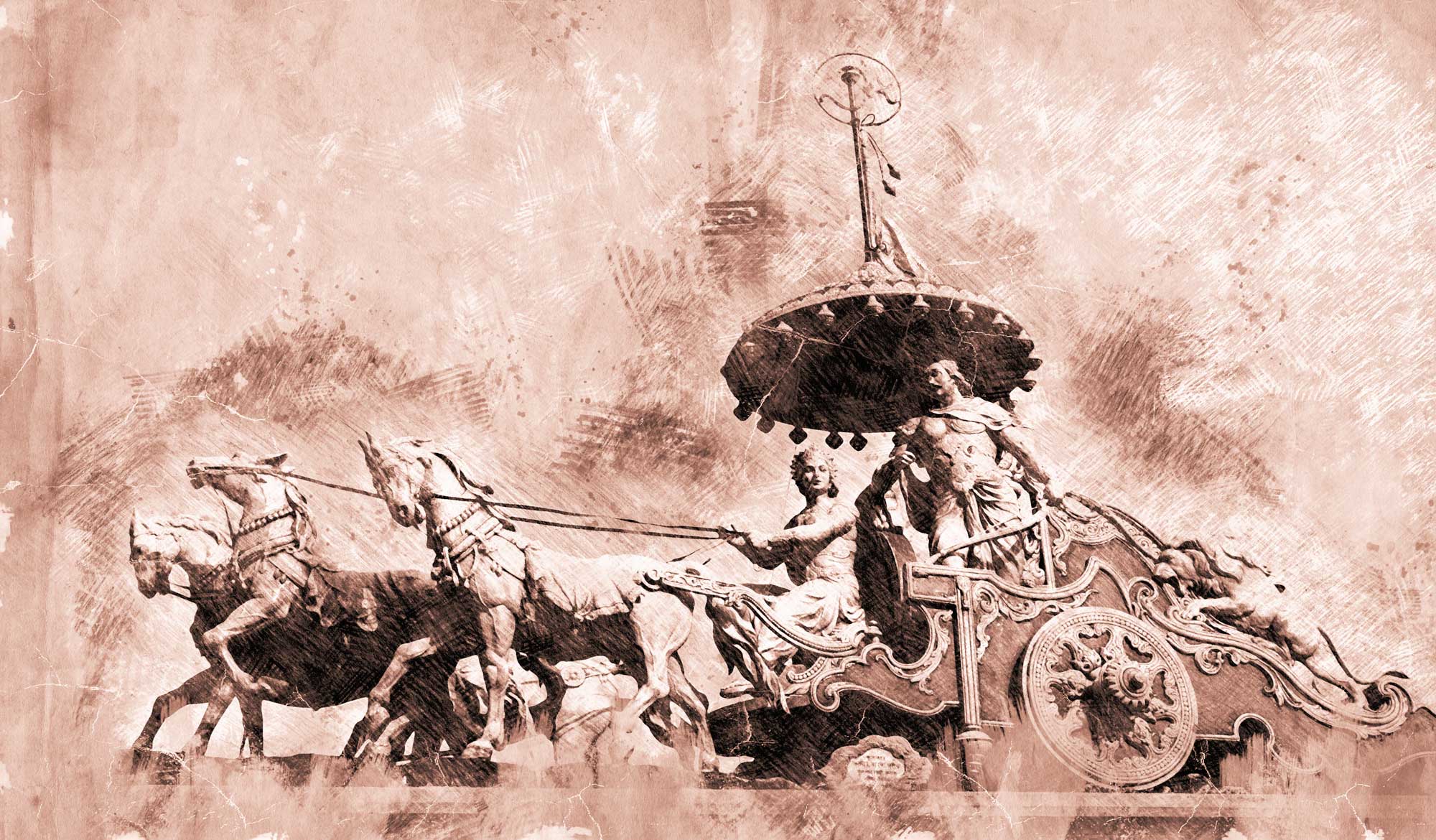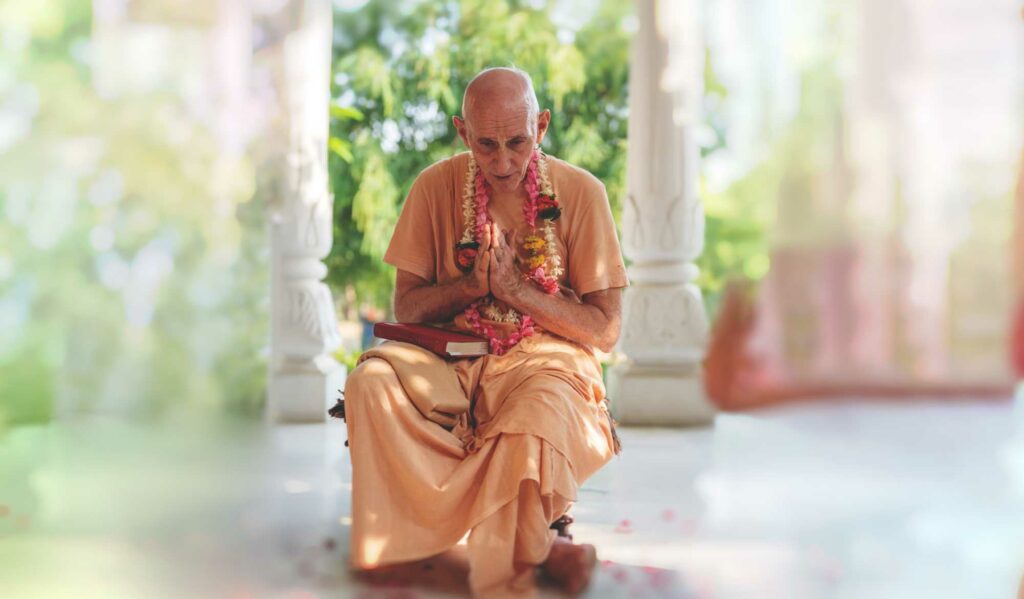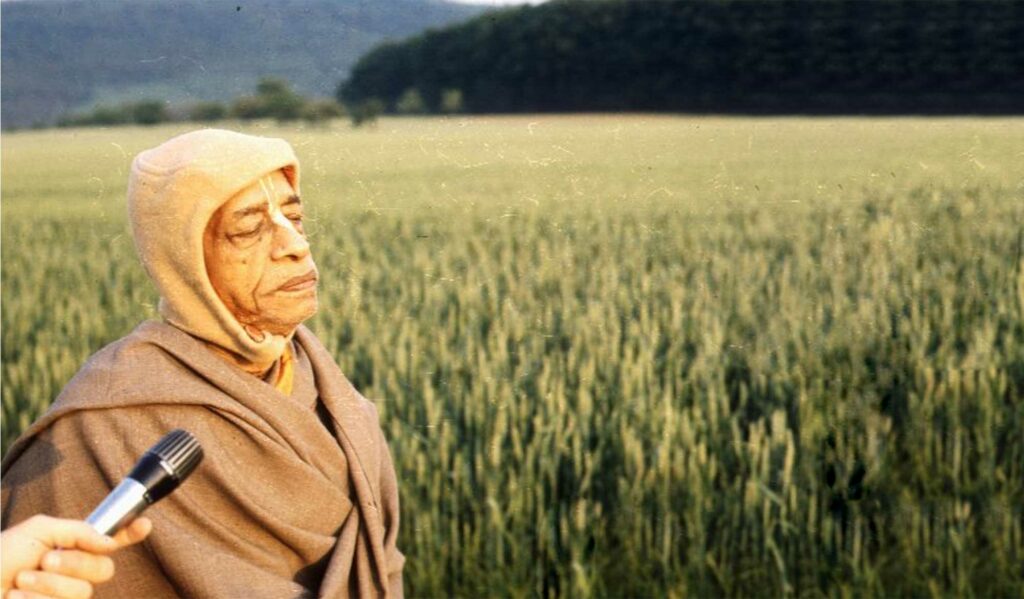Overview
This introduction to the Bhagavad-gītā by Śrīla Śrīdhara Deva Gosvāmī was written for the Bengali edition of the Gītā published by Śrī Caitanya Sārasvata Maṭha in 1961. Śrīla Śrīdhara Mahārāja expounds the glories of the Gītā and explains how śaraṇāgatī (surrender) is its ultimate message. This article was translated into English by Sanātana Dāsa.
vande śrī-guru-gaurāṅgau rādhā-govinda-sundarau
sa-gaṇau gīyate cātha gītā-gūḍhārtha-gauravam
(I offer obeisance unto Śrī Śrī Guru-Gaurāṅga Rādhā-Govindasundara along with Their associates, as I sing the glorious and confidential purport of the Bhagavad-gītā.)
The book Śrīmad Bhagavad-gītā is well-known to the learned and cultured society of people, therefore, an introduction by the editor of this book concerning its conceptions have been given herein. The editor is a follower in the transcendental line of the school of thought represented by Śrī Caitanya. Thus the readers should consider that this present edition has been published based on deliberations on the commentaries of Śrī Gītā by the Gauḍīya ācārya-mahājanas Śrī Viśvanātha, Śrī Baladeva and Śrīla Bhaktivinoda Ṭhākura. Inspired by the mercy of Śrī Guru-pāda-padma Oṁ Viṣṇupāda Śrīla Bhaktisiddhānta Sarasvatī Gosvāmī Prabhupāda, as well as indications given by the aforementioned mahājanas, some new meanings have been revealed here and there, uncovering some esoteric explanations. Devotee readers will especially appreciate this if they give a little attention to the meaning of the catuḥ-ślokī (four verses) of the Tenth Chapter of Śrī Gītā as described by Śrī Viśvanāthapāda.
In general, Śrī Gītā is an unparalleled treatise on the science of dharma. The language of Śrī Gītā is simple and beautiful. Its mood is deep, extensive and fundamental. Its reasoning is concise, clear, and unbiased. Its logic is strong and natural. Śrī Gītā’s prologue, epilogue, discourse, review, analysis, synthesis and technique of presentation are extremely unique and appealing to the heart. Śrī Gītā is motivation for the lazy, courage for the timid, hope for the hopeless, and a life-giving medicinal herb (sañjīvanī) for the dying. Śrī Gītā is a harmoniser and guardian to everyone – be it a revolutionary, a tāntrika, an industrialist, a liberationist, or a līlāvādī (one who has faith in the Lord’s pastimes). Beginning from the most gross-minded atheist to the most pious religious person, the essential conceptions of all classes of philosophers have been presented here with strongest and clearest reasoning. Be it the karmī, the jñānī or the devotee of Bhagavān – all sampradāyas will see the essence of their own respective conceptions in a complete and splendorous manner, and for this reason everybody adores this king amongst books. The essential purport of the instructions found in the Aryan Vedas and Upaniṣads has been directly revealed, and if one pays a little attention, one can see that the essence of other non-Aryan religious conclusions is also revealed in this book. In the performance of selfless activities (niṣkāma-karma) prescribed by śāstra, one’s consciousness eventually becomes purified leading to self-realisation (ātmā-jñāna) or knowledge of the true nature of things (vastu-svarūpa-jñāna) or realisation of transcendence, and when this pure knowledge is completely developed, one discovers blissful prema-sevā (divine loving service) in the spiritual world. This is the aim found within the Gītā.
From the perspective of sambandha-jñāna (knowledge of one’s relationship with the Supreme), Śrī Gītā has instructed us to see the Supreme as a conscious personality endowed with form. From the perspective of prayojana (the ultimate necessity of life), it has mentioned that the cultivation of various expressions of bhāva (divine ecstasy) for the Supreme Truth is the highest achievement. And from the perspective of abhidheya (the process of achieving the goal), the first step is performing activity dedicated to Bhagavān, then the cultivation of knowledge of the self which is dependent upon realisation of Bhagavān, and finally, casting aside all other endeavours, one takes shelter of the process of śaraṇāgati (surrender) or śuddha-śraddhā (pure transcendental faith), and in one’s perfected spiritual form (siddha-svarūpa) renders prema-sevā to Śrī Bhagavān which means performing sādhana by taking full refuge in the sādhya (the objective) – this is what is taught.
Śrī Gītā has clearly shown the respective differences and unique characteristics of each of the various paths, namely demigod worship, the paths of karma and jñāna, and the paths of material enjoyment and liberation. Therefore, those who create confusion by saying that all types of sādhya and sādhana are one and the same have been ruled out when Śrī Gītā deliberates on various gradations and distinctions – yo yac-chradhaḥ sa eva saḥ (‘one is judged by his particular faith’). Intelligent people can consider this.
In this regard, these ślokas are also worthy of special consideration:
tapasvibhyo’dhiko yogī jñānibhyo’pi mato’dhikaḥ
karmibhyaś cādhiko yogī tasmād yogī bhavārjuna
yoginām api sarveṣāṁ mad gatenāntarātmanā
śraddhāvān bhajate yo māṁ sa me yuktatamo mataḥ
Such a yogī is superior to the tapasvī (one who performs severe penances), the jñānī (one who tries to achieve the Absolute by intellectual pursuits) and the karmī (one who tries to attain salvation by performing Vedic rituals). This is My conclusion, O Arjuna – therefore become a yogī! I consider the best of all yogīs to be the bhakti-yogī who abides in Me, who meditates upon Me and who worships Me with firm faith. (Bhagavad-gītā 6.46-47)
Śrī Gītā makes a very bold and fundamental contribution by declaring the futility of renunciation. Instead of renouncing work, it has been recommended to perform karma-yoga (offering one’s actions to the Lord) or performing selfless activities as an offering to Bhagavān, and ultimately work inspired by Bhagavān in a state of śaraṇāgati or bhakti which is the Gītā’s ultimate and highest instruction. In summary, from the finest consideration, Śrī Gītā is the king amongst books in that it bestows the highest bhakti. In its most complete manifestation this bhakti, which is the full expression of prema-bhakti, applies only to the blissful, beautiful nature and form of śrī-kṛṣṇa-tattva.
Sarva-dharmān parityajya mām ekaṁ śaraṇaṁ vraja – regarding the loud declaration of this great message, Śrī Gītā has sung the glories of life’s highest objective. Starting with saṅkīrtana it takes the form of bhāva–sevā – confidential, more confidential, and the most confidential instructions have been given in relation to full surrender in cultivating service to Śrī Bhagavān. Those who have taken shelter at the feet of Śrī Caitanya-candra, the avatārī and saviour of Kali-yuga, consider this to be the proper perspective based on their own good discernment and the true paramparā. Śrī-Kṛṣṇa samarpitam astu (May this be an offering unto Śrī Kṛṣṇa.)
Tridaṇḍi-bhikṣu
Śrī Bhakti Rakṣaka Śrīdhara
Śrī Caitanya Sārasvata Maṭha, Navadvīpa
Śrī Janmāṣṭamī,
Bengali Year 1368 (1961 CE)
Read Articles and Books related to Bhagavad-gītā
- 📖 Bhagavad Gita – Swami B.G. Narasiṅgha Mahārāja’s Commentary (Book)
- 🎧 Bhagavad Gita Audiobook (Swami B.G. Narasingha Maharaja)
- ❔Bhagavad-gītā FAQs
- 📖 Bhagavad Gita As It Is – Original 1972 Macmillan Edition (Book)
- The Secret of the Lord’s Appearance According to the Gītā by Śrīla Bhaktivinoda Ṭhākura
- Introduction to the Bhagavad-gītā by Śrīla Śrīdhara Mahārāja
- The History of the Bhagavad-gītā by Swami B.V. Giri
Further Reading
Prema Dhāma Deva Stotram with the Narasiṅgha Sevaka Commentary – Verses 61-65
In verses 61 to 65 of 'Prema Dhāma Deva Stotram', Śrīla Śrīdhara Mahārāja narrates the pastime of Śrī Caitanya at Caṭaka Parvata In Purī and explains how the scriptures produced by Brahmā and Śiva are ultimately searching for the personality of Mahāprabhu who is merciful too all jīvas, no matter what their social position.
Prabhupāda Śrīla Sarasvatī Ṭhākura’s Visit to Ayodhyā
With the forthcoming observance of Śrī Rāma Navamī, we present 'Prabhupāda Śrīla Sarasvatī Ṭhākura’s Visit to Ayodhyā' written by Śrīla Bhaktisiddhānta Sarasvatī Ṭhākura Prabhupāda from The Gaudīyā magazine, Vol 3. Issue 21/ In December 1924, after visiting Benares and Prāyāga, Sarasvatī Ṭhākura visited the birth-site of Śrī Rāmācandra in Ayodhyā.
Śaraṇāgati – The Only Path to Auspiciousness
In this article, 'Śaraṇāgati - The Only Path to Auspiciousness', Dhīra Lalitā Dāsī analyses the process of śaraṇāgati (surrender) beginning with śraddhā (faith). She also discusses the role of śāstra and the Vaiṣṇava in connection with surrender.
Ātma Samīkṣā – The Value of Introspection
In this article, "Ātma Samīkṣā – The Value of Introspection" Kalki Dāsa highlights the importance of introspection in the life of a devotee and especially in relation to the worldly environment that surrounds us. He also explains how transcendental sound influences our capacity to introspect.
Prema Dhāma Deva Stotram with the Narasiṅgha Sevaka Commentary – Verses 61-65
In verses 61 to 65 of 'Prema Dhāma Deva Stotram', Śrīla Śrīdhara Mahārāja narrates the pastime of Śrī Caitanya at Caṭaka Parvata In Purī and explains how the scriptures produced by Brahmā and Śiva are ultimately searching for the personality of Mahāprabhu who is merciful too all jīvas, no matter what their social position.
Prabhupāda Śrīla Sarasvatī Ṭhākura’s Visit to Ayodhyā
With the forthcoming observance of Śrī Rāma Navamī, we present 'Prabhupāda Śrīla Sarasvatī Ṭhākura’s Visit to Ayodhyā' written by Śrīla Bhaktisiddhānta Sarasvatī Ṭhākura Prabhupāda from The Gaudīyā magazine, Vol 3. Issue 21/ In December 1924, after visiting Benares and Prāyāga, Sarasvatī Ṭhākura visited the birth-site of Śrī Rāmācandra in Ayodhyā.
Śaraṇāgati – The Only Path to Auspiciousness
In this article, 'Śaraṇāgati - The Only Path to Auspiciousness', Dhīra Lalitā Dāsī analyses the process of śaraṇāgati (surrender) beginning with śraddhā (faith). She also discusses the role of śāstra and the Vaiṣṇava in connection with surrender.
Ātma Samīkṣā – The Value of Introspection
In this article, "Ātma Samīkṣā – The Value of Introspection" Kalki Dāsa highlights the importance of introspection in the life of a devotee and especially in relation to the worldly environment that surrounds us. He also explains how transcendental sound influences our capacity to introspect.








